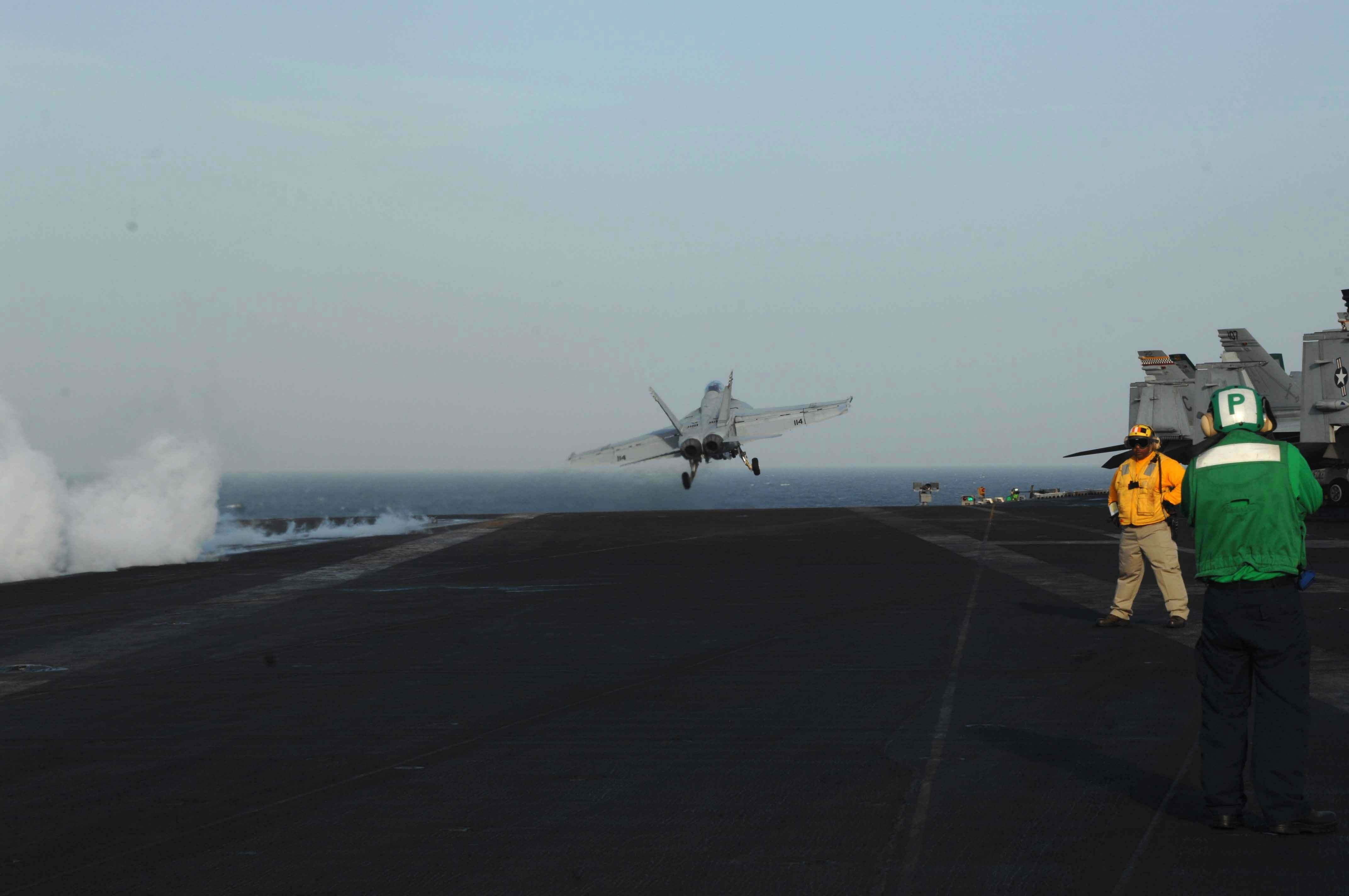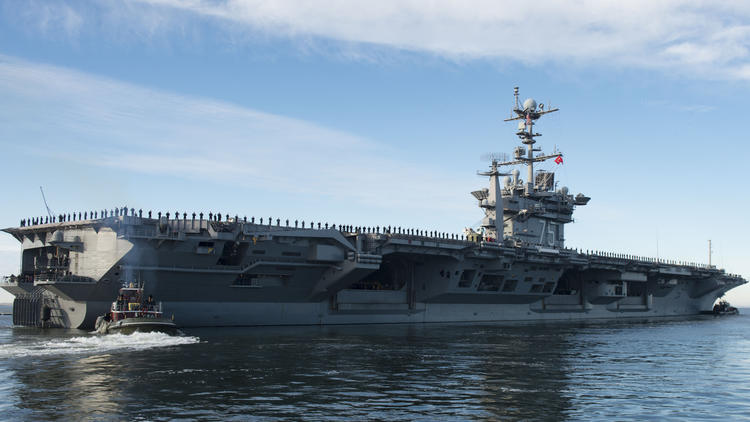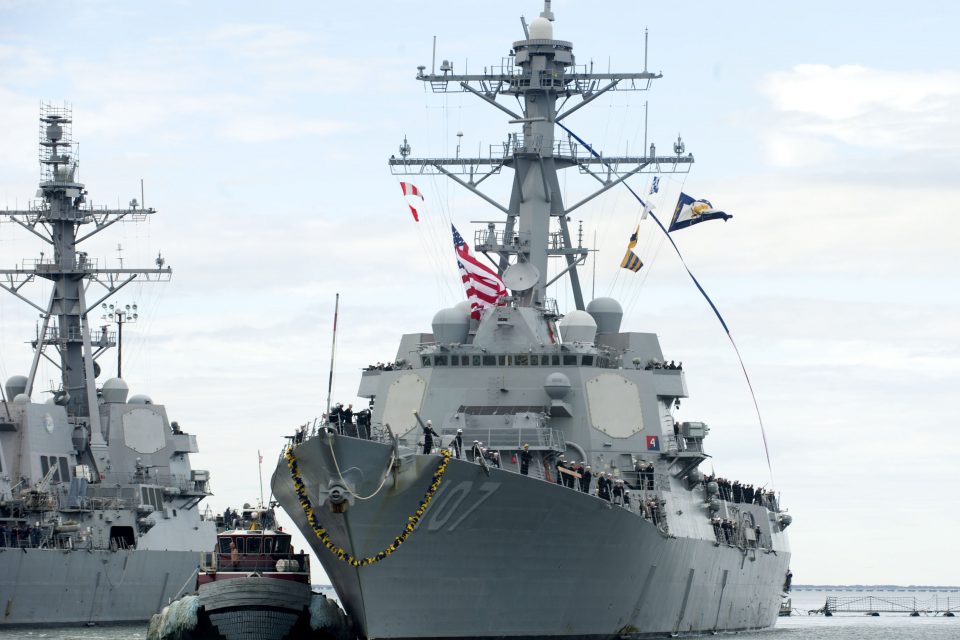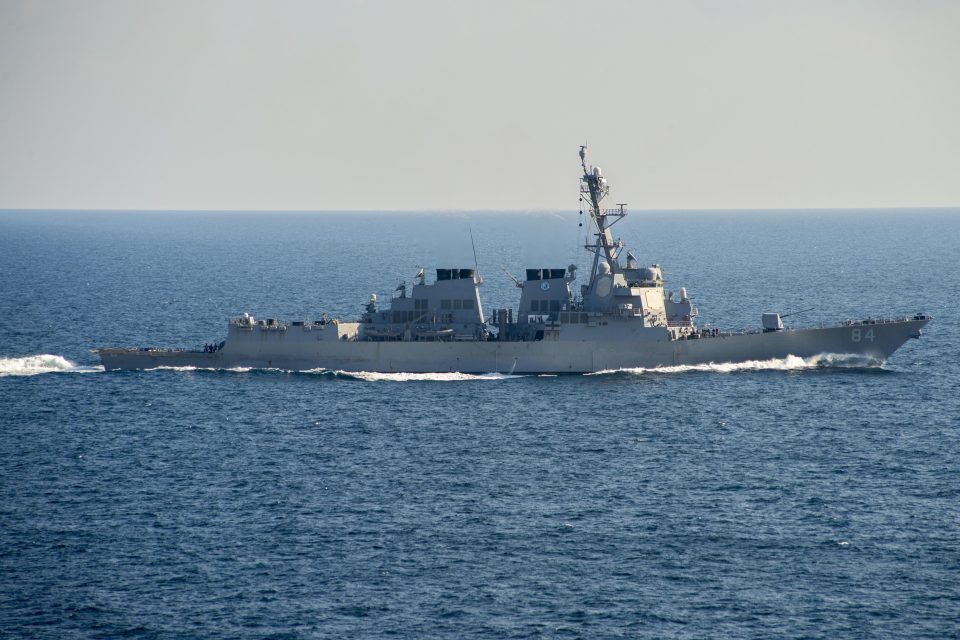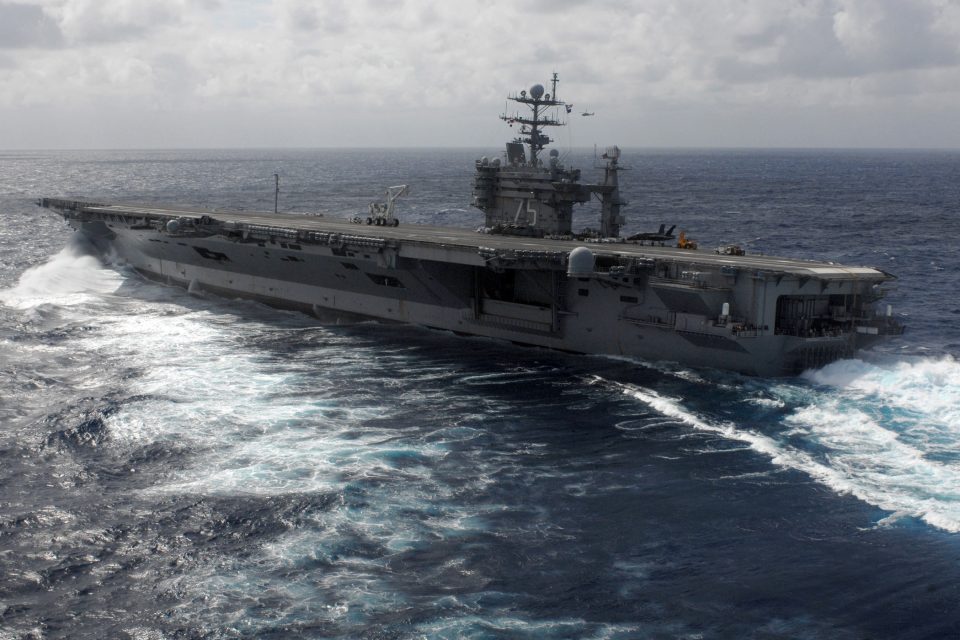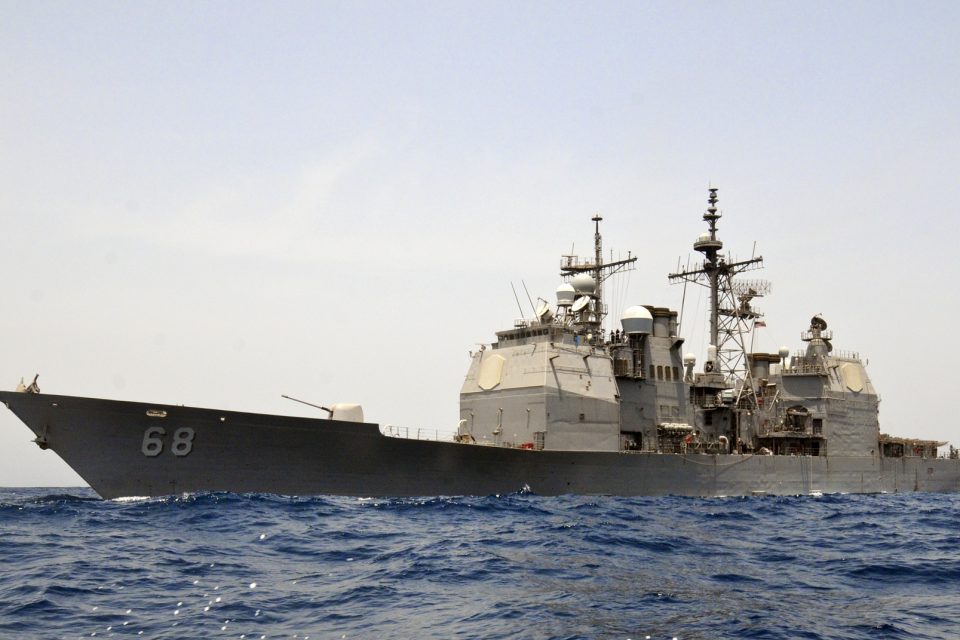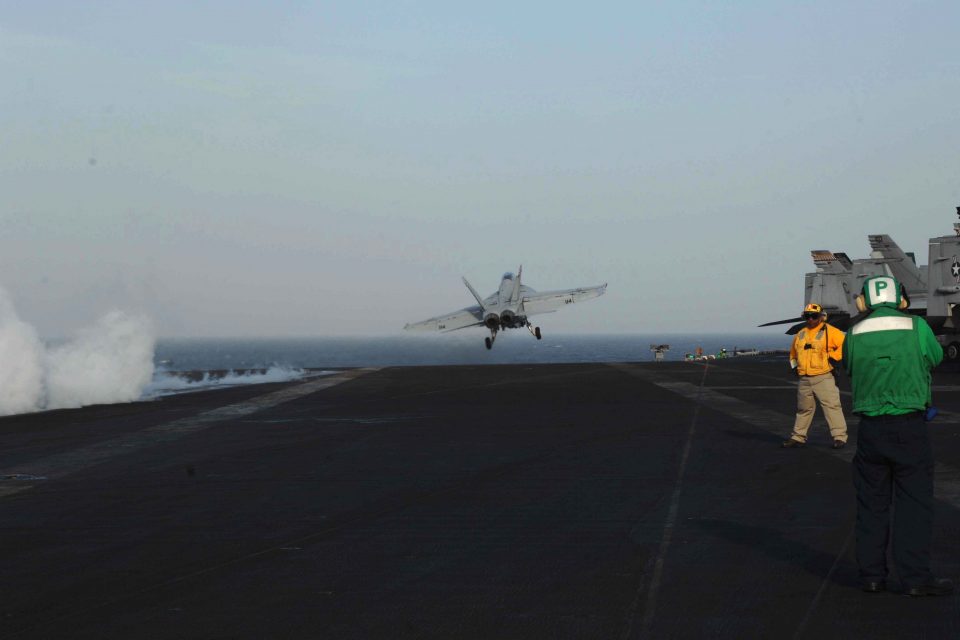2015-11-16 By Ed Timperlake
In a fight against ISIS, a non-state force with the resources of a state, air strikes and insertion of forces can not only lead to the destruction of forces in being but infrastructure supporting those forces.
What you do not want to have are forces which can be captured by the radical Islamists and used as pawns in a deadly game.
The sea services provide a unique set of assets as flexible expeditionary strike groups made up of amphibious ships or a carrier strike group and can bring a diversity of assets to bear on fixed or fleeting targets.
As a retired Marine commented on the recent ISIS attack on Paris:
“ISIS is so drunk on their own venom, that they have seriously underestimated the resolve of the French.”
And, as well, the solidarity of those forces unwilling to see civilized society decimated by the barbarism of Islamic militants.
When a strike force like the Truman goes to sea, it is a commitment of the military and their families to defeating the kind of evil represented by ISIS,
Yesterday, the USS Truman, with surface combatants set out into Harm’s Way with families, loved ones and supporters of the United States Navy waving good-by as the Strike Group left Norfolk Naval Base, through Hampton Roads and then cleared Willoughby Spit and was visible from Little Creek Amphibious Base and many historic Civil War fortifications.
Much like the fanatical Nazis celebrated their sense of ethnic purity against the “weaker” Anglo-Saxon races, ISIS believes its ideological purity will prevail over the “weakness” of the West.
The fleet represents what America has become — a powerful multi-ethnic society, that in spite of its differences, finds ways to work together, notably against those who seem dedicated to the extermination of civilized society.
Those who are honored or events remembered by having ships named after them represent the best of America and its armed forces.
The Truman is of course named for President Truman, a man who demonstrated courage in combat and in leadership of the United States.
The USS Anzio, a Ticonderoga Class Guided Missile Cruiser, is named for the battle of Anzio, where American and allied forces fought off of the beaches and finally broke out to pursue the Nazis in northern Italy.
The Burke Class Destroyer USS Bulkily is named for Vice Admiral John Bulkeley, MOH, known as “The Sea Wolf.”
The citation listed in Arlington Cemetery for Vice Admiral Bulkeley highlights his accomplishments.
For extraordinary heroism, distinguished service, and conspicuous gallantry above and beyond the call of duty as commander of Motor Torpedo Boat Squadron 3, in Philippine waters during the period 7 December 1941 to 10 April 1942.
The remarkable achievement of Lt. Comdr. Bulkeley’s command in damaging or destroying a notable number of Japanese enemy planes, surface combatant and merchant ships, and in dispersing landing parties and land-based enemy forces during the 4 months and 8 days of operation without benefit of repairs, overhaul, or maintenance facilities for his squadron, is believed to be without precedent in this type of warfare.
His dynamic forcefulness and daring in offensive action, his brilliantly planned and skillfully executed attacks, supplemented by a unique resourcefulness and ingenuity, characterize him as an outstanding leader of men and a gallant and intrepid seaman.
These qualities coupled with a complete disregard for his own personal safety reflect great credit upon him and the Naval Service.
The USS Gravely Burke Class destroyer is named for Vice Admiral Gravely.
Samuel Lee Gravely Jr. was a highly decorated Navy Officer who pioneered the way with a multitude of firsts for African Americans in the military.
Some of his most notable achievements included, being the first African American Navy Vice Admiral, the first African American to command a Navy warship, the first African American to command a warship during combat, the first African American to command a Navy Fleet, and the first African American to obtain Flag Rank in the military.
His decorations include the Bronze Star, Legion of Merit, Navy Commendation Medal, and Meritorious Service Medal.
The USS Gonzalez Burke Class destroyer is named for Sgt Alfraedo Gonzalez MOH,
Alfredo Gonzalez, who was posthumously awarded the Medal of Honor for heroism in Vietnam in February 1968, was born 23 May 1946, in Edinburg, Texas. He graduated from Lamar Grammar School in 1955, and from Edinburg High School in 1965.
Enlisting in the U.S. Marine Corps Reserve at San Antonio, Texas, 3 June 1965, he was discharged to enlist in the regular Marine Corps, 6 July 1965.
He completed recruit training with the 3d Recruit Training Battalion, Marine Corps Recruit Depot, San Diego, California, the following September, and individual combat training with the 2d Battalion, 2d Infantry Training Regiment, Marine Corps Base, Camp Pendleton, California, that October.
After completing individual combat training, he became a rifleman with Headquarters and Service Company, 1st Reconnaissance Battalion, 1st Marine Division, and served in that capacity until January 1966. He next saw a one year tour of duty as a rifleman and squadron leader with Company L, 3d Battalion, 4th Marines, 3d Marine Division. He was promoted to private first class on 1 January 1966; to lance corporal on 1 October 1966; and to corporal on 1 December 1966.
Upon his return to the United States in February 1967, he saw duty as a rifleman with the 2d Battalion, 6th Marines, 2d Marine Division, Camp Lejeune, North Carolina.
Ordered to the West Coast in May 1967, he joined the 3d Replacement Company, Staging Battalion, Marine Corps Base, Camp Pendleton, California, for transfer to the Far East.
On 1 July 1967, he was promoted to sergeant, and later that month, arrived in the Republic of Vietnam. He served as a squad leader and platoon sergeant with the 3d Platoon, Company A, 1st Battalion, 1st Marines, 1st Marine Division.
While participating in the initial phase of Operation Hue City in the vicinity of Thua Thien, Vietnam, on 4 February 1968, Sergeant Gonzalez was mortally wounded from hostile rocket fire.
A complete list of his medals and decorations includes: the Medal of Honor, the Purple Heart, the Presidential Unit Citation, the National Defense Service Medal, the Vietnam Service Medal with two bronze stars, the Vietnamese Cross of Gallantry with star, the Vietnamese Cross of Gallantry with Palm, the Military Merit Medal, and the Republic of Vietnam Campaign Medal
It is a fleet which honors great Americans, and make no mistake, great Americans serve today in the fleet.
One hopes that the opening lines of Gladiator are what awaits the Isis: “Unleash Hell!”
Editor’s Note: A good overview of the departure of the Truman strike group was provided by Ali Rockett of the Daily Press and published on November 16, 2015:
The aircraft carrier Harry S. Truman and its strike group left Naval Station Norfolk Monday for a deployment set to start in the Middle East as U.S. and coalition forces increase strikes on Islamic State militants, who have claimed credit for last week’s attacks in Paris.
The Truman is expected to reach the Persian Gulf before the year’s end. The U.S. has been launching air strikes into Iraq and Syria from aircraft carriers in the Persian Gulf — at least until last month, when the USS Theodore Roosevelt left the area after an extended deployment.
The two-month gap is the first in nearly a decade that the U.S. has had no carrier in the region.
While the Truman’s departure date was set more than a year ago, it came about six months earlier than first planned. In October 2014, it was announced that the ship would switch deployment cycles with the Norfolk-based USS Dwight D. Eisenhower, which required an additional 10 months in the shipyard.
This means the 3,000 sailors aboard the Truman readied the ship for deployment in about half the normal time.
Another 2,000 sailors are attached to the carrier’s flotilla, which includes guided-missile cruiser USS Anzio, and guided-missile destroyers USS Bulkeley, USS Gravely and USS Gonzalez, the Navy said. Carrier Air Wing 7, with nine squadrons, is also assigned to the group.
The seven-month deployment will also include operations in the waters around Europe and Africa.
The guided-missile destroyer USS Ramage also departed Norfolk Monday for an eight-month deployment in the Middle East. It will be independent of the carrier strike group and will provide ballistic missile defense, according to the Navy.
The photos in the slideshow highlight the various ships in the Truman strike group.
The first photo shows an F/A-18F Super Hornet, assigned to the “Swordsmen” of Strike Fighter Squadron 32, launches from the flight deck of the aircraft carrier USS Harry S. Truman (CVN 75).
Harry S. Truman, flagship for the Harry S. Truman Carrier Strike Group, is seen deployed to the U.S. 5th Fleet area of responsibility conducting maritime security operations, supporting theater cooperation efforts and supporting Operation Enduring Freedom (1/9/14).
The second photo shows Guided-missile cruiser USS Anzio (CG 68) steams through the Gulf of Aden. Anzio is assigned to Combined Task Force 151, a multi-national, mission-based task force established by the Combined Maritime Forces in January 2009 to conduct counter-piracy operations in the Red Sea, Gulf of Aden, Somali Basin and Arabian Sea (7/15/11).
The third photo shows the aircraft carrier USS Harry S. Truman (CVN 75) conducts high-speed turns during a rudder check. Harry S. Truman is conducting carrier qualifications in the Atlantic Ocean (3/14/09).
The fourth photo shows the guided-missile destroyer USS Bulkeley (DDG 84) transits the Gulf of Oman. Bulkeley, part of the Harry S. Truman Carrier Strike Group, is deployed to the U.S. 5th Fleet area of responsibility conducting maritime security operations, supporting theater security cooperation efforts and supporting Operation Enduring Freedom (11/26/13).
The fifth photo shows the guided-missile destroyer USS Gravely (DDG 107) returning to Naval Station Norfolk after a scheduled deployment. Gravely deployed to the U.S. 6th Fleet area of responsibility in support of maritime security operations and theater security cooperation efforts in the eastern Mediterranean Sea and conducted missions in support of Operations Sharp Sentry, Atlantic Sentry, and Active Endeavor (11/18/13).
The final photo shows the Truman preparing to depart from Norfolk Naval station and is credited to Barbette Timperlake.


